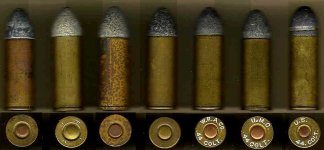jeffafd
Jr. Member
- Jul 27, 2013
- 29
- 9
- Detector(s) used
- Garrett AT Pro
- Primary Interest:
- All Treasure Hunting
Are these Minie Balls? ~ Found them today!
I'm assuming these are Minie Balls. I have found a number of them in the same area previously, but those were all fired, these I assume are unfired?
They do have nice patina on them, but unsure of age, caliber, etc... if anyone can add their input.
They are approx. 12mm across the bottom and approx. 15mm tall.



I'm assuming these are Minie Balls. I have found a number of them in the same area previously, but those were all fired, these I assume are unfired?
They do have nice patina on them, but unsure of age, caliber, etc... if anyone can add their input.
They are approx. 12mm across the bottom and approx. 15mm tall.



Last edited:




